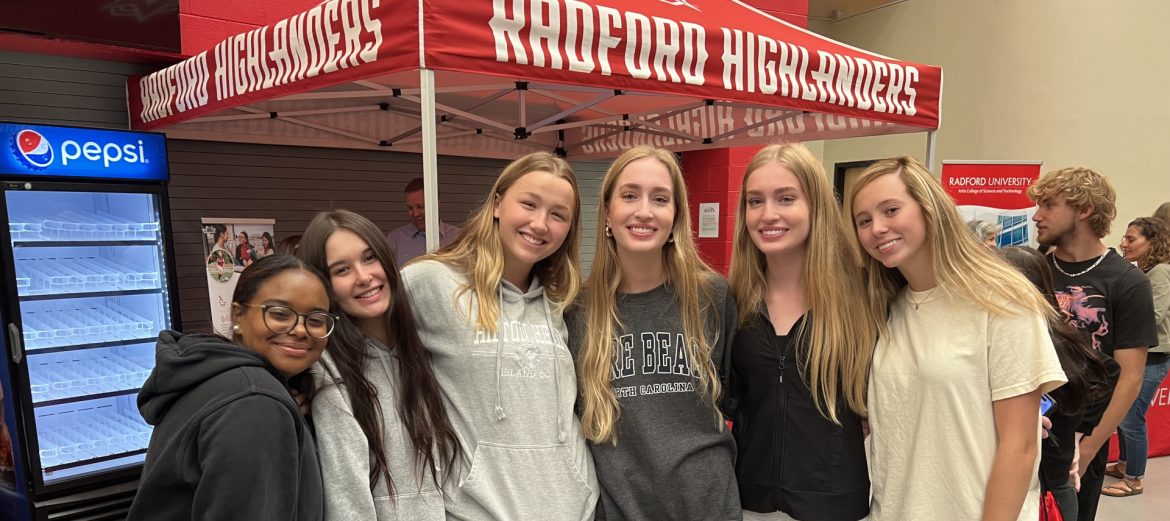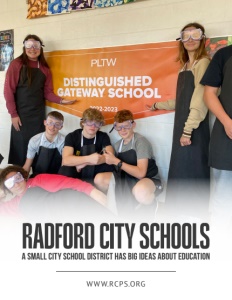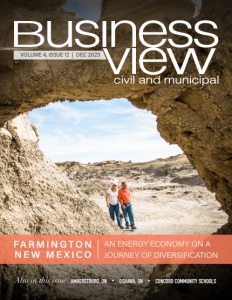Radford City Schools
A small city school district has big ideas about education
In Radford, Virginia, students learn better in an immersive educational environment
The city of Radford, Virginia, population of about 16,500, is located in the Old Dominion’s New River Valley in the south-central part of the state. Its school-age population, about 1,600 students, is served by the four schools that make up the Radford City School District: McHarg Elementary, Belle Heth Elementary, Dalton Intermediate School, and Radford High School. The mission of Radford City Schools is to “provide a challenging atmosphere in which students prepare for success in life, develop a competitive spirit, and become responsible citizens.” Its vision is: “Excellence in Education. . .Every Student, Every Day.”
“We work to achieve that vision daily,” says Ellen Denny, Assistant Superintendent for Curriculum and Instruction. “Some days are more challenging than others with regard to budget, to the teacher shortage, to changing behaviors and a plethora of other things, but I believe we aspire to provide every student excellence in education every day. And the mission is a good one. We do want to provide an atmosphere that does prepare students for success in life and to become responsible citizens. And while we want our children to be competitive in a changing world, we also want them to know the importance of working with others.”
Early education is key
In Radford, education begins early. The district has one three-year-old preschool class and three preschool classes for four-year-olds. It partners with Head Start, the national child development program for children from birth to age five, as well as with the Virginia Preschool Initiative, which provides funding for quality preschool programs for at-risk four-year-olds. “Preschool experience is really important for their success in subsequent grades,” Denny notes. “Obviously, kindergarten is here to get our kids ready, but we want our students to be ready when they hit that grade, so we can propel them forward and not play the catch-up game.”
The district also partners with the United Way’s Kinder Camp initiative, a three-week program designed to bring at-risk preschoolers, who did not have the opportunity to attend preschool, into a school setting, providing them a chance to learn basic skills before their first day of kindergarten. Kinder Camp students participate in a variety of learning opportunities focused on increasing skills in math, literacy, social interactions, problem-solving, and cause-and-effect.
“It’s been very successful because it gives kids who qualify an opportunity to meet the teachers and experience what the school day is going to look like prior to the school’s official opening,” Denny explains. “They’re not there with the older students and because of that, can be provided individual attention and a much more personal experience. Teachers are able to accomplish a lot with these littles in a small amount of time.”
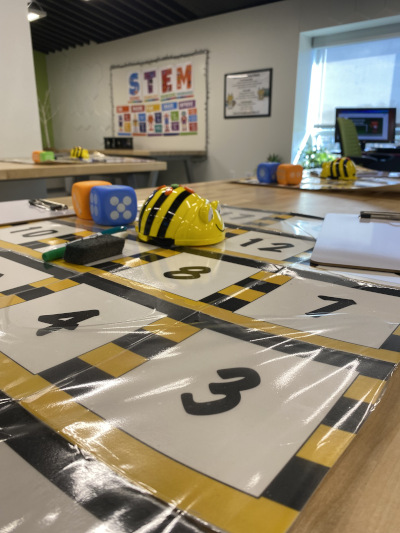 It’s not your parents’ grade school anymore
It’s not your parents’ grade school anymore
Once children progress to primary school in Radford, they become exposed to a whole new way of thinking and how they learn best. “One thing we’ve recognized in education is that learning does not have to happen in isolation,” says Cole Wilder, Principal at Belle Heth Elementary School, named after one of Radford’s leading citizens, Isabella Hammet Heth, who donated the parcel of land for the town’s original academy in the 1880s. “The days of only teaching math in math, or only teaching technology skills in a technology classroom, is outdated. We try to immerse everything within every program. This year we entered our fourth year as a ‘Project Lead the Way’ school which offers us a curriculum that promotes integrated learning.”
Project Lead the Way (PLTW) is an innovative, project-based, learning program that incorporates science, technology, engineering, and math – commonly known as STEM. It empowers students to develop and apply transportable skills, such as communication, creative and critical thinking, and collaboration, by exploring real world challenges in exciting and engaging ways. “It is a fantastic program that provides an immersive experience that includes all subjects,” Wilder continues. “It’s a framework where students start off with a problem, work through the problem utilizing problem-solving practices and reflect on the success or lack of regarding their solution. They typically solve the program with a partner or as a team.”
At Belle Heth, Wilder and his team have built two laboratories: the Creation Station, and the Innovation Station. The Creation Station is a hands-on STEM lab, but utilizes no modern technology tools. “During the pandemic, students were on devices all day, partly because they had to be. Now, we’re trying to have a STEM hands-on lab with no technology. We have tons of random things that have been donated, like Popsicle sticks and yarn and all types of things that can be used to make things,” Wilder says. “So, teachers can teach a novel and at the end of the novel study the kids get to go into the lab and choose from a hundred items to build something as a culminating activity regarding the novel.”
“Our Innovation Station is all technology,” he adds. “We have some robots, some coding activities, and some electronics. Everybody gets one three-week lesson co-taught by our librarian and our ITRT (Instructional Technology Resource Teacher). They have worked with all the classroom teachers to figure out what they’re studying in class and how they can apply some type of technology to the lesson. We are working to intertwine all content, skills and concepts. We include technology into our math classes, our reading classes, our history classes, our science classes. Eventually, the goal is that you’d be in a class and not know if it’s a math, English, reading, or history class because it’s totally integrated. The brain works best when it’s making connections across multiple disciplines.”
Because of its forward-thinking approach to education, Radford City Schools was recently designated by the State Board of Education of Virginia as a ‘School Division of Innovation.’ “And we happen to be the only one in the state last year that was given that award,” says Denny. “Our teachers have done such a remarkable job learning the strategies and techniques around STEM education and partnering with our ITRTs to become familiar with the PLTW curriculum to provide engaging experiences for all students. Kindergarten and preschool students are involved in STEM activities because we understand the value and impact to our youngest students if they are able to access processes early on. STEM experiences demand cooperation and critical thinking and exploration. And that goes all the way up to high school.”
STEM is for everyone
“These initiatives are for all students, not just for the top or gifted students,” notes District Education Specialist, Jamie Little. “We offer the chance for all students, K-12, to engage in the innovative practices in STEM.” Little is also the district’s liaison to the area’s college, university, and business partners. One instrumental organization that works with Radford’s schools is Radford University; it recently provided the district a grant to get cyber security instruction to its students, early on. Another key collaborator is Virginia Tech in nearby Blacksburg, which offers programs via its Center for Educational Networks and Impacts.
“There is a local liaison in each of the school divisions surrounding Virginia Tech,” Little explains. “We’re on campus one day a week. If there are departments, professors, or groups looking for outreach to local school systems, we serve as a liaison to them; if our teachers or administrators want some kind of programming, field trip, or experience, I try to make that connection between our school system and Tech. And we’ve been able to do some pretty awesome programming with Tech along those lines. The last couple of years, we had a ‘Passport to College’ career program with the College Access Collaborative at Virginia Tech. They came to the high school and met with our sophomores and juniors with programming preparing them for college and career — either or both.”
Reading is still fundamental
While providing alternative and innovative programs for its students, Radford City Schools also pays attention to the more traditional learning strategies, particularly when it comes to the first of the three “Rs” – Reading. “We have taken the bull by the horns concerning literacy,” Denny asserts. “We now have an elementary literacy coach who works very hard, pre-K through 6th grade, to ensure our teachers are well-trained with best practices and research-based practices in the science of reading, and that our students are getting sound instruction. The literacy program is robust and complete with many different components working together, including our special education teachers, to support all students in the quest to become literate.”
The district is also aligned with the newly formulated provisions of the Virginia Literacy Act (VLA). Passed by the state legislature in 2022, the VLA mandates “urgent and significant action to produce early universal literacy across the state.” According to the Act, beginning in the 2024-2025 school year:
- Every student in kindergarten to grade three will receive core literacy instruction based in scientifically-based reading research and evidence-based literacy instruction. Students will also receive evidence-based instruction and intervention, as outlined in an individualized student reading plan, if they do not meet literacy benchmarks.
- Every family will have access to online resources to support literacy development at home, and will be able to participate in the development of their child’s student reading plan, if their child does not meet literacy benchmarks.
- Every teacher will use evidence-based literacy curriculum, assess student learning using approved literacy screeners, use student-level data to inform instruction and intervention, and participate in pre-service preparation or training on evidence-based literacy instruction.
- Every reading specialist, in consultation with classroom teachers, will coordinate and oversee intervention for students not meeting literacy benchmarks, and will develop and monitor student progress on student reading plans, working closely with families and teachers.
- Every division will develop a literacy plan, ensure the use of evidence-based literacy curriculum, staff enough reading specialists to support intervention needs, and provide professional development to support teachers, reading specialists, and principals.
School safety is paramount
Finally, because of the dangerous times in which we live, school safety and security measures have become increasingly important to administrators, teachers, parents, and students, alike. The district has already applied some grant monies to improve school-door security and has added video cameras to its buildings. It has also partnered with the “I Love U Guys Foundation,” a non-profit organization that provides programs for crisis response and post-crisis reunification used in more than 45,000 schools, districts, departments, agencies, organizations, and communities around the world.
“We trained all of our employees under the ‘I Love U Guys’ standard emergency protocols and have told the parents what all of those protocols mean,” Denny reports. “The training gave us a more consistent, common language. We’ll use that language when we have alerts this year. We have outfitted all the schools with all the visuals; we used a security grant to make all the posters, flyers, and flip books – everything that a teacher would need in the middle of an emergency. The next step is to outfit classrooms with emergency kits to use in the event of a full lockdown, especially if it’s a long-term full lockdown. Also, this spring, we’ll be looking at taking steps toward creating a better reunification system. We have a great partnership with our police department, and we now have a school resource officer at every school. It’s money that we put toward something that we hope we never have to use. But the reality is we have to be prepared.”
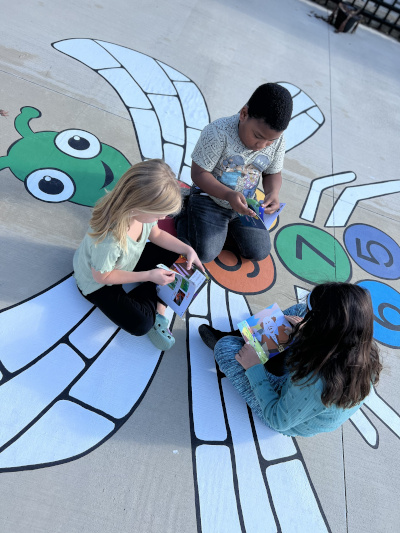 Goals for the future
Goals for the future
Going forward, the three school representatives outline their priorities: “Safety is always our top priority,” says Wilder. “We are always, every year, and within the year, revamping our security and taking a closer look at that. Instructionally, it’s continuing to give teachers what they need — whether that’s training, additional planning time, or connecting them with community resources to continue to be more creative and innovative in their teaching style. It’s not easy to start doing some innovative practices; you have to provide the resources, time, and support. So, that’s something that we’re always trying to do. The best way to provide a quality education and prepare kids for the real world is to provide immersive and innovative educational experiences.”
Little says she wants to continue to strengthen the partnerships that the district already has with its stakeholders. “Radford city officials, the universities and colleges, the local businesses, have all been really supportive,” she declares. “We’ve had special programming through our partners; we have something called ‘Bobcat Career Chat’ that our career coach organizes. We have representatives from all over our area who come to talk to our students about career choices and paths; anything that we can do to continue to prepare students for that next step of life after high school, whether it’s college, community college, trade school, work, or the military.”
“There are so many things that we always want to accomplish,” says Denny in conclusion. “Maintaining safe schools is always first and foremost, and closing the year without major incidents or distractions is a win. We also want to end each year knowing that our work had a positive impact on all students, not only academically, but socially and emotionally. Administrators, teachers and support staff work very hard to provide environments for our children that are safe, calm, peaceful, and conducive to learning so that we graduate students who are ready for their next chapter. And last, but not least, we work to grow our programs throughout the year so that we continue to provide relevant, innovative, and engaging programs to all returning and new students for years to come.”
AT A GLANCE
Radford City Schools
WHAT: A small but innovative school district with 1,600 students
WHERE: Radford, Virginia
WEBSITE: www.rcps.org
